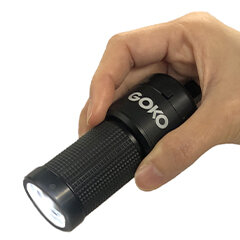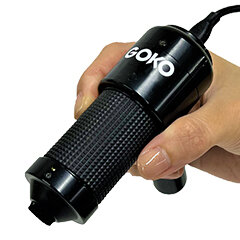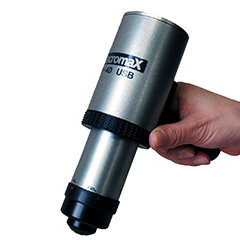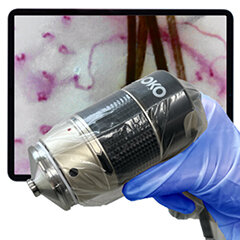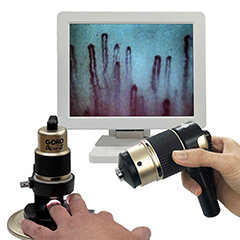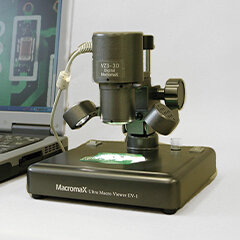Faq
The capillaries come into sharp focus so quickly ― does the capillary scope use autofocus?
No, the GOKO Bscan-ZD uses manual focus. Because capillaries lie at varying depths beneath the skin, autofocus can struggle to focus correctly and may instead lock onto surface debris or hairs. The GOKO Bscan-ZD is designed to quickly and precisely focus on capillaries just beneath the skin, delivering crystal-clear images. Its depth of field has been improved by 10% compared to previous models, allowing clearer visualization of vessels at different depths.
Can the GOKO Bscan Series quantify blood flow?
Yes, it can.
Both the GOKO Bscan-ZD and Bscan-ZA models connect to a PC and come standard with the "GOKO Measure" software, allowing you to capture and save still images and video. By the optional "GOKO-VIP" software, you can quantify blood flow velocity. The advanced "GOKO Measure
Plus" software adds even more capabilities, including capillary morphology analysis, panoramic image stitching, and click-based vessel counting.
This makes the GOKO Bscan Series an ideal choice for researchers and healthcare professionals who need precise blood flow analysis.
Can I observe blood flow outside of the nailfold areas?
Absolutely. By detaching the camera from the stand, the GOKO Bscan Series allows full-body capillary observation. It can be used to visualize blood flow in a variety of areas, such as:
- Scalp (frontal, crown, and occipital regions)
- Arms and legs
- Tongue, gums, and oral mucosa
- Facial skin for cosmetic assessment (spots, dullness, anti-aging)
For enhanced clarity, the optional non-reflex cap reduces LED glare and allows for even clearer visualization.
Can this capillary scope be used to verify the effects of health supplements?
Yes. Blood flow analysis is commonly used in the research and development of health foods and dietary supplements. With the GOKO Bscan Series, you can visually confirm changes in capillary flow speed or vessel dilation before and after supplement intake. The system is widely used in clinical studies by universities and research institutions in the health food industry.
It also plays a growing role in research related to blood flow improvement and prevention of lifestyle-related diseases.
Which areas of the body are easiest―and hardest―to observe capillaries?
Easier to observe:
- Nailfolds (commonly used in rheumatic and diabetic circulation studies)
- Thin-skinned areas such as arms, legs, and cheeks
More difficult to observe:
- Thick keratinized areas like heels
- Hairy areas, (for the sculp we recommend the optional non-reflex cap)
The GOKO Bscan is also used in animal studies, such as analyzing blood flow in skeletal muscle before and after physical activity.
Can the GOKO Bscan Series be used in beauty and anti-aging applications?
Yes, it is gaining attention in the emerging field of "beauty × blood flow analysis." The GOKO Bscan is already in use by cosmetic brands and aesthetic salons.
Research suggests that hyperactive blood flow may be associated with areas prone to skin discoloration, such as age spots. This device enables real-time visualization of skin microcirculation, allowing users to make informed decisions for skincare and anti-aging strategies.
Can this device support research on systemic sclerosis (SSc)?
Yes. The GOKO Bscan Series is actively used in studies of microcirculation abnormalities in systemic sclerosis (SSc), particularly for Nailfold Video Capillaroscopy (NVC).
Its high magnification enables detailed observation of capillary shape changes and reduced flow velocity, making it ideal for research into autoimmune diseases such as SSc.
Can it measure changes in blood flow after physical activity?
Yes. The GOKO Bscan Series is widely used in sports science and rehabilitation to monitor real-time changes in blood flow before and after exercise.
It is ideal for analyzing skeletal muscle perfusion and is even used for checking athlete condition and recovery.
